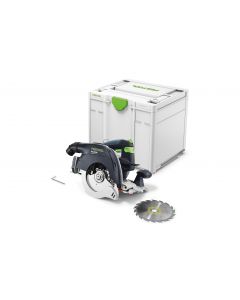Request a free tool trial or demonstration and experience the Festool difference. Request a Demo >>
Video Transcript
You may find yourself working up on roofs. You could be working on ladders. These really need a lightweight circular saw, something you can cart quite easy, and is versatile. Other applications we could possibly use a saw for like this would be for cutting doors down.
Let’s consider cutting doors, cutting sheets, full sheets on site and also plunge cutting. These things are where we might need to cut a vent out of a door, or even a sink, or cut a sink out of a bench top. They are all areas that could require a plunge saw. Using such a tool allows us to be fairly flexible.
Here are some key factors to keep in mind when you're looking at purchasing a circular saw. Look at the application and at the versatility of the tool. Can you use it with a rail, can you cut different materials with it, is it lightweight? A really important thing these days, because we are cutting so many different materials, is can you use dust extraction and does it effectively remove dust?
Take a look at an application where we may want to cut a beam. On-site we know that if we’re just cutting a square one, we'd measure it out first. We then use the square and pop on the square mark. The whole idea is that we've got to follow that line with our blade. Some of these jobs can become quite challenging, because in this case, with this particular beam, we've got recesses in it. A lot of the time we need to cut from both sides to do that cut.
How can we make that a little bit faster and what sort of systems can I bring into it? We want to see if other systems can offer a rail that makes it a lot quicker. We talked about possibly taking a beam to a drop saw. We lift the beam up and we take it across. With this particular system, we can connect that onto the rail and this gives us our degrees of cut. Whatever we need to cut on that particular rail, we can then lay onto the surface and we can do the cut directly over it.
That is a simple thing that really enhances the speed of the application. These are the sort of things that you want to look for. We may be cutting doors down or cutting sheet down with rails. We need to make sure that we can get the right type of rails and there are different rails for that. The benefit of being able to locate that saw on to the rail and to be able to cut doors and cut sheets and so on, is we can look at a quality of cut.
We might be using this for framing, rough framing and so on. But when we want a good quality cut, we can fit the blades with a splinter guard and still get a really good quality of cut. For rip cutting and so on, we can use a parallel fence. We can put that on where we need to rip down the middle of the timber. These are important things to keep in mind when you're thinking about purchasing your system.
Consider things like protractors where we can transfer the angle directly from the work piece onto the rail and do a really quick cut, without using a bevel. Then it’s transferring the mark from the angle onto the sheet and extending the angle. We can put all this onto the rail to make it extremely quick.
For fast ripping cuts and for cross-cutting, it's good for doors and panels and so on. There is a system built around it that can definitely make your work quicker. Also, different accessories can make sure that we get the best dust extraction. We can target the dust and really get it away from the work place. Obviously working with dust extraction also means we can work more quickly and easily, and it also saves time on cleanup.
We want a versatile system. We really want to consider that when we're looking to buy a circular saw. It needs to be something you can use for quite a few different applications. It might be rough cutting but you also got the benefit of being able to use it for cut quality where it might be sheeting or doors and so on.
So there you have it. This is the circular saws buying guide you need to know. If you want to know a little bit more about this, you can contact us here. We've got guys out there who will come and see you on site. You can use the tools, you can see how the system works and see how it'll benefit you.
Request a free tool trial or demonstration and experience the Festool difference. Request a Demo >>









